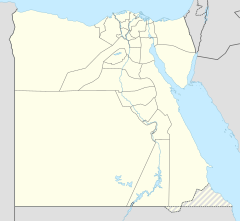Ras El Tin Palace
This article needs additional citations for verification. (December 2009) |
| Ras El Tin Palace | |
|---|---|
 The palace seen from the Port of Alexandria, 1983 | |
| General information | |
| Type | Palace |
| Architectural style | Italian Renaissance |
| Town or city | Alexandria |
| Country | Egypt |
| Coordinates | 31°11′57″N 29°52′07″E / 31.19917°N 29.86861°E |
| Current tenants | President of Egypt |
| Construction started | 1834 |
| Completed | 1847 |
| Client | Muhammad Ali Pasha |
| Technical details | |
| Floor area | 17,000 m2 (180,000 sq ft) |
| Design and construction | |
| Architect(s) | Ernesto Verrucci-Bey |
Ras El Tin Palace (
. Ras El Tin Palace is the oldest royal Egyptian palace still in use.History
The palace is located in the Ras el-Tin quarter of Alexandria overlooking the city's Western Harbour.
Built on a rise above the harbour on the eastern seashore of Alexandria, the palace is one of a number of construction developments in the city initiated by Muhammad Ali to serve as a vice-regal palace. Initially based on the shape of a Roman fort,
Style

Ras El Tin Palace has the shape of a large Italian Renaissance palace, with architectural elements and ornamentation inspired by that era, along with Baroque and Moorish elements.[9] It was erected on a foundation of 17,000 square metres (4.2 acres), surrounded by elaborate gardens of 12 feddans (13 acres). Fig trees (Arabic – teen) were already on the palace site, inspiring its name Ras Al-Teen. Through the reign of successive kings the complex was used as their residence and the government headquarters during the summer season.
Various rulers made changes to the palace. It was totally reconstructed by
After the
Current usage
The formal garden is open to the public, but not the palace itself.[1] A naval base is located next to the palace.[12] The palace has been used for hosting state guests and events in recent years. There is no public museum, unlike the Montaza Palace royal gardens and museum, also in Alexandria.
See also
- List of palaces in Egypt
- Royal Jewelry Museum – Fatma Al-Zahra Palace (Alexandria)
References and notes
- ^ ISBN 9781409323334.
- ISBN 9789774161926.
- ^ including Yezi Bek, his assistant La Vial, and Le Veroige.
- ^ a b c "Ras el Tin Palace: description, facts, history, photo". Sharm Club. 12 December 2018.
- ISBN 9781780763576.
- ISBN 9781904381280.
- ^ ISSN 0024-3019.
- ^ Paul Crompton (25 January 2014). "The overthrow of Egypt's King Farouk: a dramatic departure from power". Al Arabiya English.
- ^ ISSN 0024-3019.
- ^ cost = L.E$400,000
- ^ Christopher Payne, François Linke 1855–1946, The Belle Époque of French Furniture, Antique Collector's Club 2003, p.269
- ^ Kibler, Joan F. (March–April 1996). "Alexandra team wrapping up pier, ship support facilities, at navy base". Transatlantic News. Vol. 11, no. 3. Public Affairs Office, Transatlantic Division, U.S. Army Corps of Engineers. p. 6.
![]() Media related to Ras el-Tin Palace at Wikimedia Commons
Media related to Ras el-Tin Palace at Wikimedia Commons

